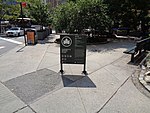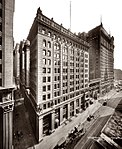Alexander Macomb House
Broadway (Manhattan)Buildings and structures demolished in 1940Demolished buildings and structures in ManhattanFinancial District, ManhattanHouses completed in 1788 ... and 8 more
New York City as the National CapitalPresidency of George WashingtonPresidential homes in the United StatesPresidential residences in the United StatesSlavery in the United StatesUse American English from October 2019Use mdy dates from October 2019Washington family residences

The Alexander Macomb House at 39–41 Broadway in Lower Manhattan, New York City, served as the second U.S. Presidential Mansion. President George Washington occupied it from February 23 to August 30, 1790, during New York City's two-year term as the national capital. The building was demolished in 1940.
Excerpt from the Wikipedia article Alexander Macomb House (License: CC BY-SA 3.0, Authors, Images).Alexander Macomb House
Broadway, New York Manhattan
Geographical coordinates (GPS) Address Nearby Places Show on map
Geographical coordinates (GPS)
| Latitude | Longitude |
|---|---|
| N 40.7063 ° | E -74.0132 ° |
Address
Harriman Building
Broadway 39
10006 New York, Manhattan
New York, United States
Open on Google Maps










